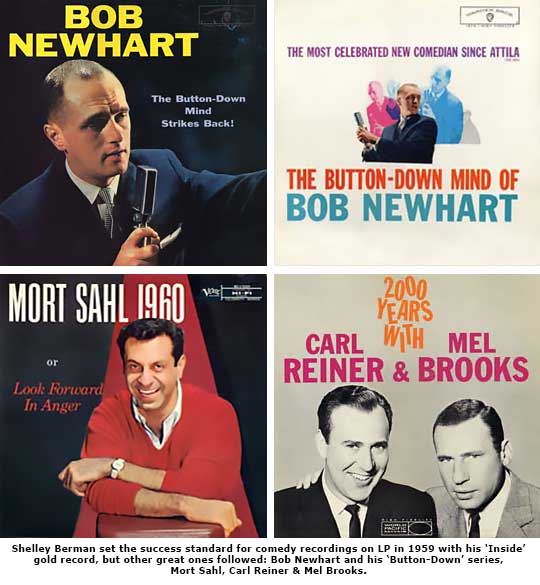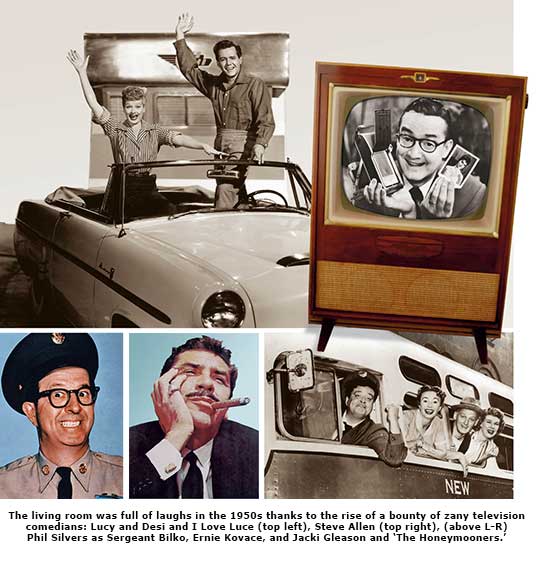Laughing Stock of the Mid-Century - Page 2
For Bruce, the reactions of the authorities and of the more uptight segment of the pubic worked well in his stand-up routines, as did race relations, religious dogma, and the pretensions of lesser comedians. Bruce's arrests and trials for alleged obscenity made him something of an early champion of free speech.

Bruce was also a role model for those with a penchant for mouthing off, as were such later luminaries of the San Francisco comedy stage as Jonathan Winters and Phyllis Diller. Diller's bawdiness might be considered something of a throwback to the burlesque tradition, though with a thoroughly modern and far-out sardonic twist. However, she pretty much played herself on stage (with ample asides about her husband, 'Fang'), while Winters transformed himself into a menagerie of the sort of Midwestern whackos he'd grown up with in Ohio.
Meanwhile, in Chicago, a group of young actors in the Compass Players discovered comic gold in their streams of improvisation. Shelley Berman took an act built on anguished telephone conversations to the stand-up stage and to unprecedented sales (and a Grammy award) on LP. Bob Newhart, another Chicago-area native, based his stand-up act on sketches, but his 'button-downed' image was an extension of his previous career as an accountant and copywriter.
Both of these Chicagoans are still in the business, and Berman, though he didn't think about it back then, can now reflect on the profound changes he and his peers wrought on the art of comedy. They wanted to evolve past the established formula of set-up and punch line.
"We didn't want to tell the 'big joke,' and those of us who did were not looked upon well," Berman pointed out in a recent interview. "We'd had a terror in our country about opening your mouth—and comedy, as a matter of fact, had become very placid, very ordinary, just ordinary jokes. But here we [the Compass Players] were, in the background, doing improv, and we were saying whatever we wanted, because we had no fear."
Unlike some of the West Coast luminaries, Berman and Newhart didn't mine the hazardous material of political criticism. Berman praises the example set by TV's Jackie Gleason and Sid Caesar in the decade preceding his own debut. "They did not make fun of the country—they were just guys being intensely funny, but intensely self-directed," says Berman. "They came out as a result of the repression, but they weren't hurting anybody."

Black comedians such as Dick Gregory and Redd Foxx, both from St. Louis, were more inclined to take on racial and social issues, as did Bill Cosby, Nipsey Russell, and Godfrey Cambridge, in very different ways.
The medium of television grew up alongside mid-century comedy, in the process discovering how to make use of it. Sid Caesar's 'Your Show of Shows' in 1950 was followed a year later by the long-running 'I Love Lucy,' starring Cuban bandleader Desi Arnaz and his then-wife, the film comedienne Lucille Ball, in a paradigm sitcom built on zany situations.
Things got even zanier on the tube in 1952 with the elaborately produced visual stunts and impersonations of 'The Ernie Kovacs Show,' and the multiple personalities of the main star of The Jackie Gleason Show, who went on to sitcom legend a few years later on The Honeymooners.
Although 'The Ed Sullivan Show' preceded all of the above, TV's variety format only occasionally and cautiously allowed for stand-up comedy, which found a much more cordial and talented host in Steve Allen, himself a comic performer (and jazz musician and composer) on 'The Tonight Show,' beginning in 1954, and 'The Steve Allen Show' a couple of years later.
'The Phil Silvers Show,' which began in 1955, had its title star, a character actor with stage and film experience, satirizing a peacetime Army and setting the standard for sitcom assaults on established institutions, persisting to the present day. These pioneering efforts helped jumpstart the careers of several comic performers and advance the appetite for humor among American consumers.
Meanwhile, comedians and record companies continued to try to follow Shelley Berman's early and enviable standard of success. In 1960, a year after Berman's 'Inside' album, 'The Button-Down Mind of Bob Newhart' went so far as to borrow Berman's phone prop, in the process beating out both Elvis Presley and the soundtrack from 'The Sound of Music' at the top of the pop charts. Stan Freberg put his pointed parodies of popular culture onto both 45-rpm singles and LP's.




